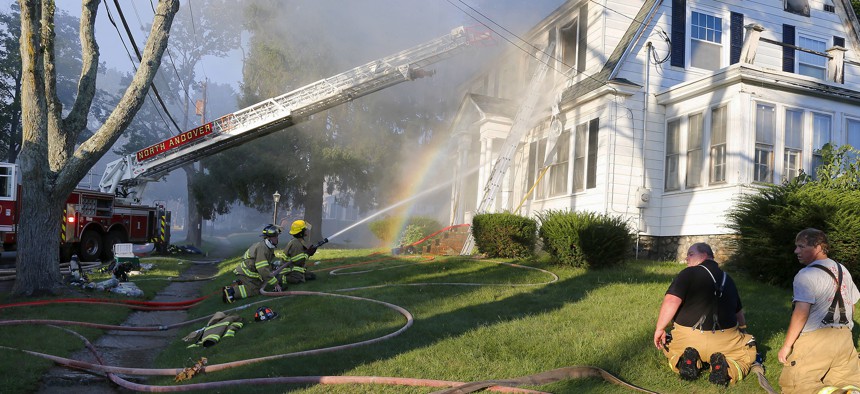Fires and Explosions Spread Across Three Towns. They Worked Together to Respond

Firefighters battle a house fire, Thursday, Sept. 13, 2018, in North Andover, Mass., one of multiple emergency crews responding to a series of gas explosions and fires triggered by a problem with a gas line that feeds homes in several communities. AP
Fires and explosions tore across three Massachusetts towns last fall, the result of over-pressurized gas lines. Here's how officials say they banded together to contain the emergency.
On Sept. 13, 2018, a work crew completed installation of a gas pipeline at an intersection in Lawrence, Massachusetts. Unbeknownst to the workers, contracted by utility provider Columbia Gas, the abandoned pipeline contained an active sensor that detected the line’s depressurization and responded by opening the main supply valve, directing more and more gas into the system. Within hours, the pipes flowing beneath Lawrence, as well as neighboring cities Andover and North Andover, were over-pressurized.
“It was one hundred times more pressurized than its intended design, and every subsequent main and server connection to every home within a 5-square-mile radius shared that pressurization,” Andrew Maylor, state comptroller of Massachusetts and former town manager of North Andover, said Tuesday at ICMA’s annual conference in Nashville. “If you had a gas appliance with a pilot...those pilots became blowtorches.”
The results were quick and devastating. In the course of one afternoon, the three municipalities saw 132 fires and multiple explosions. Dozens of structures were destroyed, at least one person died, and neighborhoods throughout the region were flooded with the smell of natural gas. Roughly 8,800 buildings were affected. It was, Maylor said, “absolute chaos.”
At first, Lawrence, Andover and North Andover responded separately to the cascading emergencies, fighting fires, dispatching first responders and trying to determine the areas affected by the problem. But officials soon realized the three towns should coordinate their efforts, which they began by creating a joint command post at a closed movie theater in Lawrence.
Working together, the communities coordinated with the state to shut down electricity to broad sections of the community to minimize the risk of further fires, and evacuated residents from neighborhoods across the region. The request to leave was tricky, officials said, because they could not immediately identify which areas were most at risk and also had no timeline to offer residents for when it might be safe to return home.
“People were sitting in their front lawns, it happened to be a nice night, and they were asking, ‘Can I go back in my house? Am I impacted?’” said Andrew Flanagan, town manager of Andover. “And we had to come up with a communications strategy that basically said, ‘Maybe, stay tuned.’ You’re basically saying to the public, ‘We don’t exactly know, and we don’t know when we will know.’”
Due to the uncertainty, officials opened shelters for displaced residents in all three communities. They also put out the call to neighboring municipalities asking for first responder help, and then set up a common staging area along a stretch of highway to organize and dispatch those resources to the areas where they were most needed. That was key, Flanagan said, as the response was overwhelming.
“Mutual aid played a critical role. We had assistance from 180 fire departments from three states, over 600 law enforcement units and 54 EMS units,” he said. “Anytime we called for an additional task force or an additional alarm, we would get more than expected, so having that staging area was very helpful.”
Regional and state officials initially worked on recovery with Columbia Gas. But when the response lagged, Gov. Charlie Baker declared a state of emergency and tapped Eversource, a competing utility provider, to oversee management of the gas system in the affected area, a process that included manually checking that each of the roughly 8,600 affected meters were turned off. Electricity was restored two days later, and displaced residents gradually moved back to their homes, though many remained in shelters and hotels for months as gas line replacement projects took longer than expected.
The utility issued its own statements throughout the process but did not offer a communications strategy to local officials, Maylor said, making it increasingly important for the three towns to work together to coordinate their own response.
“Our three communities chose to replicate all communication, and no single platform was effective. We have to assume everyone gets their information in different ways, so we took advantage of Facebook, Twitter, Instagram, Reverse 911, and CodeRED,” he said. “Anytime we went before the press or went to the press, we made sure messaging was the same between the three communities.”
In July, Columbia Gas settled multiple class-action lawsuits for a total of $143 million, which included $80 million for the affected communities. Maylor said the communities were “happy” with that amount, but added that the total cost of the disaster for the utility was estimated to exceed $1.4 billion. Cooperation among the three communities continues, Maylor said, and is instrumental to the ongoing rehabilitation of the region as a whole.
“We disagreed on very little,” he said. “Our staffs and communities saw that we were working in concert, and that was important to the process here.”
Kate Elizabeth Queram is a Staff Correspondent for Route Fifty and is based in Washington, D.C.

NEXT STORY: Noise Pollution Hurts Wildlife, But States Have Trouble Turning Down the Volume





